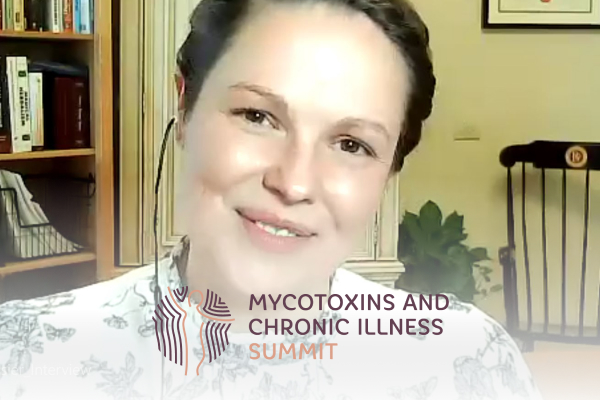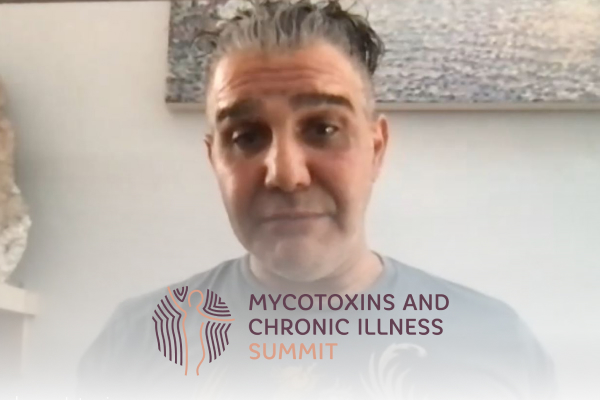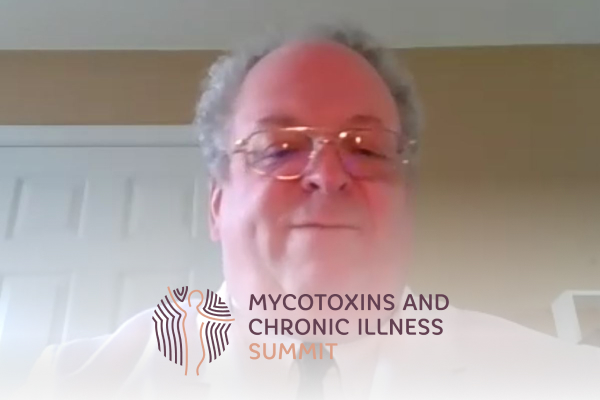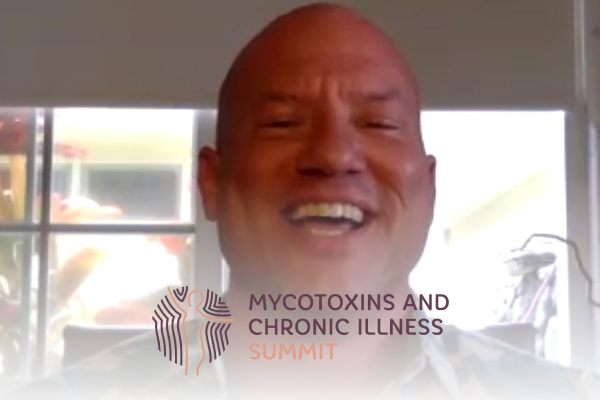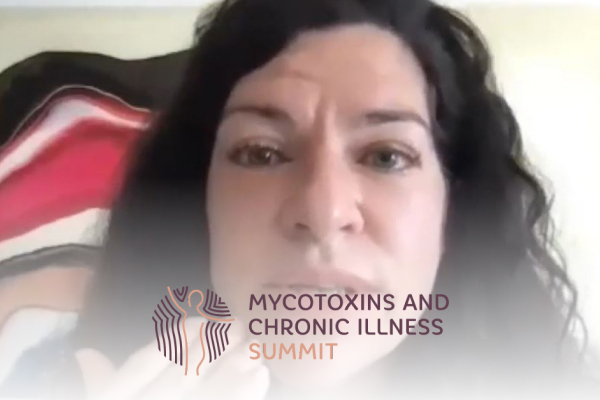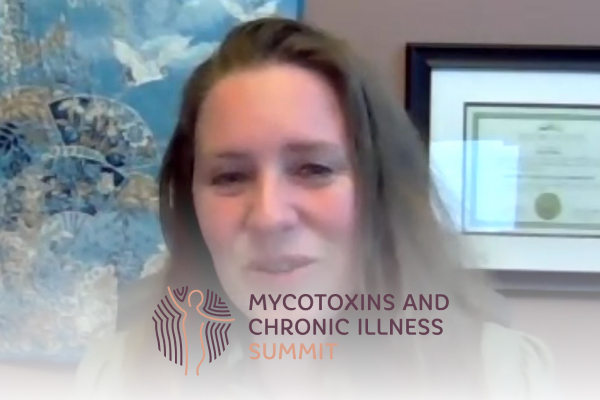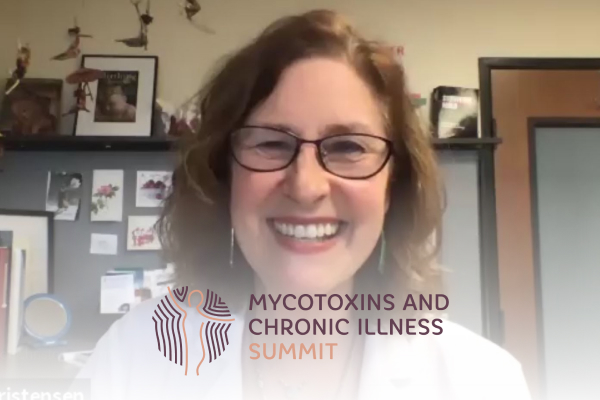Join the discussion below

Nafysa Parpia, ND has an independent practice at Gordon Medical associates, specializing in the treatment of Lyme disease and other complex chronic illnesses such as autoimmunity, mold toxicity, fibromyalgia, environmental toxicity and gastrointestinal disorders. Her patients with chronic Lyme Disease are typically those who either do not do well with antibiotics, or prefer... Read More

Lauren Tessier, ND, is a practicing Naturopathic Physician licensed by the state of Vermont. Her practice Life After Mold in Waterbury, Vermont is the East Coast’s only formerly certified, CIRS-literate Naturopathic practice. Life After Mold services patients suffering from multi-symptom, multi system illness, complicated by co-morbid conditions such as MCS,... Read More
- Different approaches to diagnosis and treatment
- Triggers for autoimmunity
Nafysa Parpia, N.D.
Welcome to this episode of the Mycotoxin and Chronic Illness Summit. I’m so excited to interview Dr. Lauren Tessier today. Dr. Tessier is a practicing naturopathic physician, licensed by the state of Vermont. Her practice Life After Mold in Waterbury Vermont, is the East Coast only formally certified CIRS literate, Naturopathic practice. Life After Mold services patients suffering from multi-symptom, multi-system illness, such as MCs, MCAS and chronic infections, including Lyme and co-infections, EBV CMV and more. Dr. Tessier also provides clinical and corporate consults to physicians and corporations looking to improve their respective clinical and productivity outcomes. Dr. Tessier has served ISEAI, the International Society for Environmentally Acquired Illness since 2017 in the roles of secretary, vice-president and now president. The free e-booklet, “Mold Prevention: 101” authored by Dr. Tessier has been widely circulated and it’s suggestions implemented by many worldwide. Find Life After Mold on Twitter, Instagram, Facebook, YouTube and Pinterest. Welcome Lauren, I’m so happy to have you join us today.
Lauren Tessier, M.D.
It’s such a blessing to be here, thank you so much for having me Dr. Parpia.
Nafysa Parpia, N.D.
Thank you for being here. So I know that your approach is actually pretty similar to my approach to treating mold and mycotoxin illness, I’d love to hear you talk about how our approach is different than some of our colleagues, so.
Lauren Tessier, M.D.
Sure, be my pleasure. To kind of get things started, I think, the key to really understanding the way we approach things is grasping the difference between mold and mycotoxins and how it can kind of interact with the body. So I know this is the Mycotoxin and Chronic Illness Summit and so you guys, by now, I’m sure are like bored to death with the concept of what is a mycotoxin? But just to kind of run over really quick guys, a mycotoxin is something that is produced by molds, by fungi, by yeast, not all molds produce mycotoxins. And so these two things, while they often go together, they are not synonymous with one another. And as a result, they can operate in the body differently and cause different disease states.
So when I’m working on approaching these things with people, what I really knuckled down on is, what part of this mold, mycotoxin dichotomy is really occurring or causing problems for these people? So in my approach, I think I kind of distill down mold illness into four different subtypes. And usually people think, oh, mold illness now synonymous with CIRS, but actually CIRS just one of the subsets. And so how I actually have people think about it, I have a little drawing here, is four overlapping circles and you guys don’t need to have anything else in your head for that, other than just that visual. And so each one of those overlapping circles, really represents a disease state that can come about from mold and/or mycotoxin exposure.
And so two of those circles are something that’s widely accepted in the greater medical community, which would be fungal allergy and fungal infection. And in fungal infection, I kind of lump in colonization too. So these are things where it is actually physically the mold organism that is interacting with the body. We have the mold potentially in the body, for an infection and a colonization, or for an allergy, we have the mold in the environment. And so the other two circles are how mycotoxins really interact with the body. And because the mycotoxins are there, the molds may or may not be there and I’ll get into that in a second for folks. And so those other two circles are CIRS, right?
That’s one of them and the other one is mycotoxicosis. And mycotoxicosis breaks down really myco, meaning fungi, right? Toxic that component and the osis is the disease state. So it’s the disease state from the toxic exposure to mold. So with mycotoxicosis, you can have mycotoxin, you can have mycotoxin exposure in the environment, so in the inhaled environment, you can have it in the food you eat, you can also potentially have it, and this is where it starts getting kind of nitpicky, in some of the mold that might be in your body. And you can also have it stored away in like some of your fatty tissues, So in the brain, the liver, subcu fat. So with mycotoxicosis the mold may or may not be there at this moment. And then finally, there’s, sorry?
Nafysa Parpia, N.D.
Go ahead.
Lauren Tessier, M.D.
Yeah. And so finally there’s like the CIRS component, which I give people the metaphor, it’s like setting up a bonfire and putting gasoline on it and lighting a match, And so you can have that fire go and at some point the gasoline is going to burn off, but the fire keeps going. And in that metaphor for CIRS mycotoxins, and it can be lots of different things, but mycotoxins are the incendiary, it’s what really gets the fire going, gets the inflammation goin and even after your detox, someone will clean them out, that inflammation can still continue.
So because of the kind of way I’ve defined mold illness, In my practice, it allows me to sit down and kind of put people and try to understand how their cases may be presenting, which then further allows me to understand what tests to order, to answer the clinical question looking after and also of course, what treatment. Because a fungal allergy treatment is gonna look a lot different from a fungal infection treatment. So that’s kind of how my approach is different from the traditional kind of CIRS biotoxin mold folks.
Nafysa Parpia, N.D.
Thank you, Lauren, that’s great. It’s actually pretty much the exact same way I look at it as well. Doesn’t surprise me at all cause we have so much in common, in the way that we practice. We’re both on ISEAI together. I wanna stop, yeah, I know it’s so exciting, right? I wanna stop and talk about the allergy piece and the carriage piece. So most of our patients will go to an allergist and the allergist will, will test IgEs and then in mold illness, IgEs don’t really show up, what we found at our clinic is that isn’t mold IgEs, molds are not expressed that way in an allergy. So the patient comes back from the allergy clinic and says, “I was told, I don’t have a mold allergy.” What we do is we test mold IgG allergies and we can just do that on Labcorp, even they have a great panel.
And find those very, very high in my patients who have an allergy, so I’ll see those levels at 20 to 200 plus, and that’s a really big deal. And so I think that it’s really important to put some light on that piece, it’s a piece that’s really, really overlooked a lot. And I find that when we put them on a Mast Cell Activation Syndrome Treatment, those IgGs, when they’re in the 200s, they’re certainly gonna come down and the symptomatic reactions of that allergy are gonna be different. And I also wanna bring up the point that the allergies, the presentation of the allergies will be different, it’s not just a runny nose or hives on the skin, but we can see that allergic response in the gut, in the bones, in the connective tissues, because that’s where mast cells live, they reside in all those tissues so the mold allergy can be there. I’m just so happy that you’re looking at that too, cause it’s not something that enough doctors are looking at. And the other thing is mold carriage, that some doctors think that there can’t be mold carriage in the body, so Dr. Tessier, tell me more about that, bout mold carriage in the body, let’s talk about that.
Lauren Tessier, M.D.
Yes, I would love to talk about that. So in my formal training, when I became ISEAI certified, of which I am no longer, I was taught that it is impossible to carry mold in the sinuses because the aw, which is the kind of grading for the water content is too low. And that’s all well and good, maybe it is pretty dry in my nose, that’s fine. But we have so much data now about the mycobiome, right? Not just the micro, but the MYCO. And we’re seeing that, we have naturally occurring fungi that hang out in our mycobiome and these guys can secrete mycotoxins, there’s this really cool piece of literature that I love and I love referencing and it is about how vaginal candida can secrete Gliotoxin, which is a huge for immunocompromised into the local vaginal bowl. Whether or not, they’ve measured if that’s been absorbed, I would say yes, but we also rely on data on that front, but it’s a perfect example of something that’s in your body, the carriage, colonization, spitting out mycotoxins and potentially adding to that mycotoxicosis so yeah, when you know, better you do better and so my thinking has very much evolved over time with that. Yeah, for sure.
Nafysa Parpia, N.D.
yeah, that’s exciting. I know when we do a nasal swab, I’ll find fungus’s in there a lot,
Lauren Tessier, M.D.
Oh yeah.
Nafysa Parpia, N.D.
In addition to MARCoNS, but it goes way past MARCoNS, It’s not just MARCoNS, but there’s a lot of bacteria and funguses and biofilm that can be found in there. And once the sinuses are treated, life changes for people. I’ve seen they can think straight again, you think about how close the sinuses are to the brain, inflammatory cytokines can cross the blood-brain barrier, infections can, I don’t know if mycotoxins can.
Lauren Tessier, M.D.
They can…
Nafysa Parpia, N.D.
Tell me about that
Lauren Tessier, M.D.
They, can, I know this, I know this, I know this for a fact, we have a animal literature, I spend way too much time in PubMed and in the animal literature. And we’re really forced to do a lot of animal literature assessment because it’s in ethical to put someone in a mycotoxin box and run tests on them, so we have to work with the data that we have and yes also the animals that we test our drugs on. So why wouldn’t we take that data into consideration? And unfortunately, that is a big argument for those viewers who are watching it’s well, it’s only in the animal literature and you’re like, well it’s also unethical for me to do this to a human. So it’s it’s nitpicky.
Anyway, so to go back to the, the nasal component, they found that insufflation, which essentially placing things into the nose of, I believe it was T-2 toxin, which is something that’s produced by a Stachy typical black molds trichothecene group that you’d find in a black, dangerous black mold. They found that it has the ability to dissolve into the olfactory nerve and then dissolve up, the olfactory nerve, and cause oxidative damage to the olfactory bulb in the brain. So it’s the perfect example of like dissolves like, that being your nerves, dissolving that lipophilic substance of the mycotoxin into that tissue and it just kind of navigating up into the brain, like the blood-brain barrier theory has been falling apart over the years and it’s a good example of it in action.
So yeah it’s so true and another piece of interesting data, and it’s an unfortunate piece of data is a mycotoxin study that was done in Nigeria of children, and it was postmortem. So they did autopsies and what they found was aflatoxin in the high fat tissues of the body, So not only the liver and kidneys, but huge deposits in the brain. Which lets you know, it’s coming from systemic circulation and crossing the blood-brain barrier. And whether that’s coming through inhalation or oral, as far as I’m concerned, at that point it doesn’t matter. You just gotta…
Nafysa Parpia, N.D.
Exactly
Lauren Tessier, M.D.
Clear out a system, you know?
Nafysa Parpia, N.D.
And then we also know from research that there can be vagus nerve translocation from the gut up to the brain, so now we can have translocation from the sinuses via the olfactory, through that research and by the vagus nerve. So there’s a lot of, I think other translocation areas in the nervous system that just hasn’t been discovered yet, which can give us direct access to the brain. Which then makes me circle back to the sinuses and colonization and how important treatment there is.
Lauren Tessier, M.D.
And I think one thing I’d like to drive home though for people is colonization is really important, but if you’re not out of mold, please reconsider pushing someone to prescribe you antifungals because antifungals, they can be a little rough on the liver, they can be rough on the heart, not a lot of people realize that. Less so something that’s locally delivered, versus orally and systemically delivered. But if you’re still in a water-damaged building with mold, you can potentially reinoculate yourself and then that antifungal is all for not, and you may have just build resistance. So I’m right there with you.
Nafysa Parpia, N.D.
yeah, Absolutely. And to continue with, with other detoxification use of binders, cause the mycotoxins are also gonna be, oftentime, until somebody is out of the environment, I’m just chasing the illness. So getting them out is really important, but while they’re still in the environment, I’m right on board with you about continuing treatment using the antifungals.
Lauren Tessier, M.D.
And in general, it’s a really good rule of thumb that you’ve just demonstrated, like you don’t do or kill, until all of your detox pathways are open and supported and you’ve got a mop and a bucket to also clear stuff up basically. Cause you’ll just, you’ll flare and, yeah, you really can’t, I think a lot of people get excited about the process of detoxing from mold, but it is not a fast process, it is not a sexy process, it is not glamorous, it’s long, it’s drawn out, it’s boring, but if it’s done right, it’s a world of difference for people, right?
Nafysa Parpia, N.D.
Absolutely, can change your life when it’s done correctly, so absolutely. So let’s talk about autoimmunity, I see it a lot in my patients and I wanna hear about how you see it in your patients, how does it present in your patient population?
Lauren Tessier, M.D.
Autoimmunity, so I tend to have a lot of females in my practice, I think in general, with holistic and alternative medicine, there tends to be a larger female practice anyway. But the largest issue that I tend to see in my clients is Hashimoto’s thyroiditis or an autoimmune thyroiditis every now and then I’ll see like a Graves popup, which is that hyper versus the hypo of Hashi’s. And then the other thing I tend to see is what I consider to be nondescript autoimmunity.
So autoimmunity is there, we just don’t know what the heck it is. So for some of you who might be familiar with autoimmunity, we do like an ANA, and then depending on what else we see, there’s little kind of sub tests that we can do to kind of differentiate it. And additionally, sometimes we look at the clinical picture and we say, oh, you have five of these 25 symptoms, that’s more lupusy or vice versa. And what I find with these clients is, they just don’t fit any of the typical autoimmune issues, but we tend to see like a speckled or diffuse pattern on their ANA pop up and be essentially devoid of a proper autoimmune diagnosis.
Nafysa Parpia, N.D.
Right, I see this all the time too, oftentimes I’ll see people with the Hashimoto’s diagnosis, but then an autoimmune tendency in the rest of the systems. And I think of the thyroid as being the canary in the coal mine, is the first one that’s gonna speak when there’s an autoimmune tendency in the body and so it’ll pop up in the thyroid first and then we’ll find even anti-gliadin antibodies elevated though they might not have a diagnosis of celiac, but we’ll see that tendency, right? Different systems of the body. So tell me why you think this is happening. tell me about, tell us about autoimmunity and why it is so often the case for people with mycotoxin and mold illness.
Lauren Tessier, M.D.
I think the unfortunate part for autoimmunity that tends to happen is that patients aren’t empowered well, I mean in general, any disease state, right? Patients aren’t being empowered and they’re not being explained about what is happening. So kind of stepping back, so it’s not too much jargon autoimmune, well your immune system has a few different branches, you mostly have your white blood cells and then there’s a few different subtypes. And those are the guys that go to that and they fight for you. In one of those subtypes, you have lymphocytes and those lymphocytes are further broken down into B-cells and T-cells. And your B-cells tend to be the ones that secrete all your antibodies and your T-cells tend to be the ones that are like on surveillance and doing the match, right?
So within that T-cell subset, this is where the autoimmunity theories really start to get put together. There’s a type 1 T helper, there’s a type 2 T helper, there’s a TH17 or a T helper 17 and then there is a Treg cells and there’s lots of other super subsets you guys don’t really wanna listen to but you’re a type 2 helper cells, you’re T helper cells, subtype two, they tend to be more involved in the allergic response and then your TH1 and TH17s tend to be more involved in the autoimmune response and then your T regulatory cells are like the cops in the space or the mediators, let’s put it that way. And they’re supposed to kind of keep everyone in check.
And so what we originally thought with autoimmunity was that the TH1 were too high compared to the Tregs. But as things have been kind of marching on, we’re realizing that it’s more the TH17, that are tending to have more of a big impact in autoimmunity, and also what they secrete, which is IL-17. So in an autoimmune picture, sometimes we’ll have elevated TH1, most of the time we’ll have a very elevated TH17 and also what they make, which is IL-17 and that’s the side that kind of, is just a chemical, inflammation, chemical. And then what we also see as a low Treg set count, essentially the mediators that go and keep everyone under control.
So with autoimmunity there’s a couple of other things that can potentially happen, Some of our anti-inflammatory cytokines, of which we definitely have, are also suppressed. So like our IL-10, which is supposed to be protective is also really low. And then we also see some of our antioxidant pathways start to have troubles too. So something like our Nrf2 can be slowed down and kind of gummed up. So of course, if you go into the medical literature and you pulls some animal studies and cell studies and all these things, you see that mycotoxins, various of them, have the ability to increase your TH17, increase your IL-17, drop your Tregs, lower that beneficial IL-10, and lower that beneficial Nrf2. So they really just set the stage for some of that immune system chaos to really occur. So that’s kind of how I’ve made the connection with mycotoxins and autoimmunity.
Nafysa Parpia, N.D.
Thank you for that. And then I also think about the bodies being stuck in a loop of that. So when we’re first exposed to an infection or an environmental toxicant and an insult like that, the body goes into an oxidative state and that’s normal and that that’s to help deal with this issue, right? The immune system’s way of protecting itself and handling the infection. The problem is when we get stuck in a loop and then we’re not able to get out of that loop and that’s when I believe the autoimmunity can present. And so getting stuck in a loop, that’s supposed to be a healing loop, at that point it’s no longer healing because we need to be able to get out of that loop and go on to the next stage of healing, that’s being stuck in the cell danger response actually, in that CDR1. And I think there’s so many other factors that lead to us getting stuck in these loops, so what I find is a lot of people will have structural integrity issues or other infections, dental, occult infections, those are huge, they’ll also have tick-borne illness at the same time and high environmental toxic load. And so the mycotoxins and the molds interacting with other environmental toxicants and other infections, so we’ve got this big soup of and toxins, and I’ve seen that for sure.
Lauren Tessier, M.D.
Oh yeah, and it’s in the data, it’s exactly what you said. We know that infections spike those TH17s and we know that infections are spiked with IL-17, but from the flip side, from the research, we’ve seen that if you suppress IL-17 you become at a higher risk of having an infection. So you’re right, it’s this really super careful dance and you know that TH17 connection with infections, absolutely, it’s there, it’s for sure.
Nafysa Parpia, N.D.
Yeah. Tell me about mold in autoimmunity.
Lauren Tessier, M.D.
Yeah, so, I’m sure to some folks that might sound like the same question and kind of, mold again in mycotoxins they’re kind of two sides of the same coin, it’s like you can have yeast, which is the organism and then you can have alcohol, which is what the organism makes. So it’s very similar, it’s the organism for the mold and then the mycotoxin, what it makes. So we know that the mycotoxins can increase gene expression of autoimmune issues, which is kinda trippy, specifically type one diabetes and Hashimoto’s. And we also know that mycotoxins can worsen issues with colitis and IgA nephropathy. And we’ve also seen mycotoxins worsen a lot of the demyelination and neurological symptoms of animal models of MS.
So that’s like the mycotoxin component, but looking at kind of mold as the organism interacting with the body, there’s a good amount of literature and starting with animals, we see that, for example candida, worsens a lot of these autoimmune models in animals, including again, the rundown, the MS, the irritable bowel disease and that IgA nephropathy. And that’s all well and good, but people get really nitpicky about the human-animal studies, but there are some really great human studies of mold impact on the body, where we’ve seen that there is a correlation, demonstrable correlation, between fungal antibodies, so meaning that there’s been an exposure or infection to MS, SLE, so lupus, psoriasis, Crohn’s and sarcoidosis, we’ve also seen for instance, mold and fungi existing in the body worsening autoimmune disease states.
So we know the severity of something like primary sclerosing cholangitis, so it’s one kind of the liver and the gallbladder get really bound and tied up in fibrosis, and they stop really working really well. That severity of that disease is worsened with the presence of candida in the system. And we’ve even seen things like being exposed to mold in an environment in particular, there’s a big one called Aspergillus fumigatus, it makes Gliotoxin, it’s dangerous, it’s problematic, can cause infections, lots of stuff. But we found that people who are sensitized to it from an allergic standpoint, so they actually have that IgE antibody, they start cross reacting with the molds cellular components with their own.
So it’s like an autoimmune IgE that can happen for folks. And I think that that was a really low, interesting piece of data that I bumped into. And then I think some of the other things that are really compelling come out of the clinical evidence that I mentioned, that we don’t get to have a lot of, but thanks to some of some bigger names from the 90s and the 2000s Dr. Campbell, Dr. Thrasher, Dr. Gray, we have these great studies that show that people who are exposed to water-damaged buildings actually have a very, very strong correlation to developing ANAs, so that kind of first pass of autoimmune disease testing.
And then they have actually a lot of neurological antibodies that then develop, and then they also have a few other antibodies, like your smooth muscle antibodies, chondroitin sulfate antibodies, mitochondrial antibodies and these are hitting like joints and liver and nervous system. And this is all stuff that has like a competence interval, like 95%. So it actually like sticks to the wall, you know? So we do see measurable levels of autoimmunity and people who have been water exposed, water-damaged building exposed. And I think one of the most profound studies, that was kind of again, a longitudinal study, was in Finland in 2017, there were a group of teachers who had been in a building for a long period of time. And they found that their autoimmune disease rate was 36.6%. When you back out and you pan out to the general population of Finland, that is typically about five to 8% for autoimmunity.
Nafysa Parpia, N.D.
Thank you for bringing up all of these studies, it’s so important. Medicine takes a long time to catch up with the literature that is sure, because most patients are told that this is idiopathic, we don’t know why you have an autoimmune condition. This is just in your genes and you’re just getting old. And it’s just the literature is there, that mycotoxins, infections, mold and other toxins do cause auto-immune conditions. And when you were talking about the different areas that the auto immunity presents, well, our patients feel that symptomatically in all those areas. So it’s just, we are ahead of the curve because, because we are taking into account the literature and as well, the clinical experience of the doctors who came before us and our own clinical experience, and I’m seeing those two match up greatly and just medicine just needs to catch up.
Lauren Tessier, M.D.
And it just, I feel like the wind has been taken out of my sails. Like it just, it bums me out so much, so so much. It’s so profoundly upsetting. And we had a human rights activist in 2017, who went before the WHO, who essentially said chronic Lyme disease has no representation in our diagnosis code bank. And as a result, that is a human rights violation, we can’t offer these people, because we can’t diagnose, we can’t offer them care, we can’t research, we can’t do any of this data collection. Her name is Jenna Luché-Thayer, if anyone wants to go, I really suggested she’s phenomenal, but we really need to have that done for mold and mold illness, cause right now the only diagnosis codes we have are fungal infection and fungal allergy.
There’s no true ICD-10 diagnosis code for CIRS, so there goes that representation and there is no true diagnosis code for mycotoxicosis, There is one, if you eat too much aflatoxin coded grain, but that’s really it, that’s where it stops, there’s no like neurological Mycotoxicosis or any of these things. And if any of your listeners happened to be someone who has any type of connections, into this field about how we can get a sea change going or something along those lines, please reach out because this is a goal that I have in my heart. It’s going to take awhile but I really wanna drive that representation because soon as we have representation, it opens up everything for our clients. So, yeah, yeah, we gonna catch up.
Nafysa Parpia, N.D.
It’s so important cause these are real illnesses, we see them clinically see them in the research, we need them to be diagnosable. So thank you for bringing that up, it’s really important piece. Let’s talk about treatment and what we do to help our patients who have mold mycotoxin illness, the allergies, all of it.
Lauren Tessier, M.D.
Sure, sure. So with mycotoxin illness, you know, it’s, it’s gonna look so different for people and something I say when I’m teaching other practitioners is there’s no dogma in medicine, there’s no dogmatism in medicine, soon as you find a strict algorithm and you can’t bust through, or you can’t bend it to change, then you have to, as a practitioner, really work to apply that to the patient, it’s an art form. And so my general global approach, it’s not a protocol, it’s a global approach, is really just the concept of working backwards and up through the body.
Most of my clients, when they come in, most of their symptoms are neurocognitive. We have a lot of neurological issues when they come in, but getting something from the brain down through the neck, to the liver and then out through the stool, that’s a long pathway for things. And there’s lots of ways that things can kind of bogged up and gummed up around that.
So when I work with people, I typically start in the gut, I work my way backwards up through the gut, supporting the gut, I work my way into the liver and do a lot of liver support and then I work backwards and kind of up through the body, meaning I’ve gone from organ system and now I’m kinda try to do more of the cellular one-on-one support and drive. And so if you open up all the dams in the river, you’re going to have a more successful treatment. And that’s what I was saying earlier on, like it’s boring, it’s not sexy by any means, it can be a slow process And frankly, I like a nondramatic treatment.
Nafysa Parpia, N.D.
I do too.
Lauren Tessier, M.D.
No one wants to go into really severe different reactions. And so I tell people, I put my oven mitts on for everyone. I am very cautious and I’ve worked with people who like, can’t drink water without developing hives and I just assume everyone is starting from there. So I might do a little bit less gut support work if they’re already on like a low inflammatory diet and they’re gluten free and they’re already doing all that stuff. But you know, biotherapeutic drainage is one of the big core components, if you’re not working with any of the phospholipids, you’re just like missing it, as far as I’m concerned, phospholipids were huge change…
Nafysa Parpia, N.D.
Huge.
Lauren Tessier, M.D.
In my treatment practice, yeah. And then after that, after you finally got up to the brain and helping the brain with a lot of detox, something that gets left on the table, at that point, that’s when I work up CIRS. If I go through that process and I’ve detox to, and you’re feeling great, then great, like you’re welcome to go, I’m here, come back to me if you need anything. But if they’re still kind of feeling funky and a little inflamed, that’s what I work up CIRS because I found that if I do the CIRS work up early, I spend tons of money and if I get people out of exposure, like 60 to 70% of my clients clear up, if we just address the mycotoxin components.
So again, that’s why it’s really important that I kind of group the different disease states so I can understand what’s happening in the system. And then kind of if CIRS does come up and we address it, the final thing that really gets left on the table by a lot of physicians is tonifying the systems. It’s great to like go through and detox and clean up inflammation and kinda get them back to a steady state, but, okay, so what’s happening with sleep. Okay, let’s try to bring some more fluids back in, let’s balance your sex hormones just a little bit more. So I feel like that gets missed a lot and that’s something that’s such a core of naturopathic practice, but you can’t do that until you’ve like laid the foundation, you need functionality to make that step.
Nafysa Parpia, N.D.
Yeah, you know I tell my patients, we have to get rid of the offenders and treat the symptoms at the same time, because they’re in a lot of pain, there are a lot of stress in their body, so treating the symptoms, treating mast cells, treating the immune system and detoxification before I even start to kill the infections, get them prepared to kill the infections. But then once we start to remove the triggers, the system is still often not in balance. So we can, one of the key piece of naturopathic medicine is treat the cause. And that’s great, we do treat the cause, however what’s missed in this patient population is once you treat the cause there’s a lot more rebalanced that needs to be done, we need to re-educate the immune system, we need to retrain the nervous system, the limbic system, the vagus nerve. There’s so much retraining that has to go on, we’re not just done once you remove the trigger, that’s when I’ll start to bring in regenerative medicine as well. It’s a whole, I tell my patients that once we’re finished with symptoms and removing the triggers, we’re on section two, which is regenerative medicine, truly retraining.
Lauren Tessier, M.D.
And some people don’t realize that that could be like, I mean, if you’re lucky, if you’re lucky, that’s six months in, but typically that’s like a year, year and a half two, like even longer for people, It took you a long time to get sick, in most instances, it’s gonna take awhile to recover, because you’re asking an already problemed system to work and healing takes work. And if you can’t even get the engine going, it’s going to take that much longer, you know?
Nafysa Parpia, N.D.
It takes a long time for patients. Six months, you’re right is lucky. Those are the people who are young, they come in, they’re in their 20s, they haven’t been sick for very long, sick for maybe a year or two, right? Six months is lucky, but usually it’s a year or two could be longer. Depending on how long the person has been sick for, how long they’ve been exposed for, what their genetic tendencies are, what’s happened epigenetically for them. Well, there’s so much to consider. So Dr. Tessier, tell us how patients can be in touch with you. Are you accepting new patients? Also tell us about, about the gift that you have to give your …
Lauren Tessier, M.D.
Yeah of course.
Nafysa Parpia, N.D.
Your viewers.
Lauren Tessier, M.D.
Yeah, so for today, for the viewers, I have put together a, essentially a mycotoxin cheat sheet, that’s going to go over some of the more common mycotoxins that you can test for, because I’m not gonna include stuff you guys can’t test for and find in your body, and on that, there is information about how it manifests in the body and potentially like where it’s found, what species of mold makes it, so that way you have like a really nice reference sheet. And then of course, people are always welcome to go to my website and download the “Mold Prevention: 101,” which is kind of like a checklist for the home, essentially, to go around and understand where there can be problems and issues in the home.
And so that when you get used to just doing normal inspections, to keep that routine maintenance in the home, and of course people can find me on all of the social media platforms, I’m on all of them. And… And then I also do in-person medical care, but I also do educational wellness consults for people who have a local provider who is overseeing them and taking care of them. And then I also do a one-on-one kind of educational training with physicians too, who are kind, looking for maybe a little bit of support hand holding, they’re looking to dive in a little deeper. And then of course I would be remiss to not mention ISEAI, where…
Nafysa Parpia, N.D.
Of course.
Lauren Tessier, M.D.
Right, practitioners can go to learn more about these topics, but then even general members, like we invite the public, you can, guys even join as a supporting member, to express your appreciation and gratitude for ISEAI. So yeah, I think that’s how people can get ahold of me.
Nafysa Parpia, N.D.
Great, well, thank you, Dr. Tessier. It was such a pleasure to interview you and I look forward to more work with you.
Lauren Tessier, M.D.
Thank you so much for today, this opportunity. Thank you for your service in doing this. Obviously this is a really wonderful thing that you guys are doing for people. And yeah, I just wish everyone good luck on finding your path or helping a friend and family member finding their path back to health through all of this. Thank you.
Nafysa Parpia, N.D.
Thank you.
Downloads

